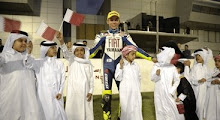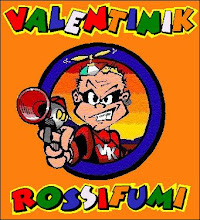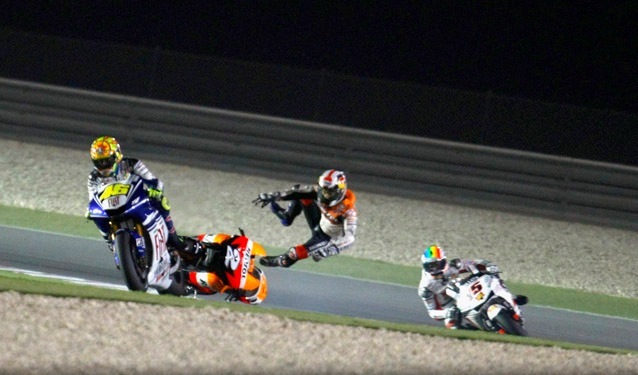
Oh no! What a race yesterday Rossi crash down after hit Randy de Puniet in the 4th GP race in Assen, Netherlands. It was really not his style to be in a hurry to in early lap just to catch Stoner. He usually wait until he and his motor is stable then he will run faster and faster. But yesterday was really shocking that he was in a hurry and hit Randy de Puniet. Poor de Puniet also fell down and couldn’t continue his race but not with Rossi. He still tried hard to get his motor stand up and continue his race until he got in 11th position (after becoming in 13th, the last position).
“I Made A Mistake”
This is what I adore about Valentino Rossi, he always say the truth. If the engine doesn’t work well he admit it, when he made a mistake he also admit it. He seems to be objective person. In the last week race, Rossi admitted that it was his mistakes to crash down and hit Randy de Puniet. He apologized to de Puniet and explained his mistakes to his fans.
Valentino Rossi, for all his undoubted talents, has never been the best of starters in MotoGP races. Identifying this as an area for improvement, and with the prospect of Assen poleman Casey Stoner making a breakaway at the head of the race, the Fiat Yamaha rider was going all-out in the Netherlands.
Unfortunately for the five-time World Champion, the gamble didn´t quite pay off, as on the opening lap he came unstuck due to a combination of over-exuberance a cold tyre and the tricky first left hander of the race.
`Unfortunately I made a mistake on the first lap, on the first left corner,´ admitted Rossi frankly after the A-Style TT Assen. `I went in too fast with a cold tyre and lost the rear.´
The Italian remounted his M1 and fought his way back to eleventh place after overtaking Marco Melandri and Toni Elias, but the rider taken out in his first lap fall was unable to do so. Rossi extended his apologies to LCR Honda´s Randy de Puniet, holding up his hand for the collision between the two.
`I took De Puniet with me when I crashed, so I have to say sorry to him. It was a bad mistake, because today we improved the setting of the bike and had great pace, and could even have challenged for the win,´ lamented the rider, having conceded the lead in the World Championship to Dani Pedrosa.
`It was an important mistake for the championship, but we are on the pace, we are fast and the championship is very long. One mistake in a year is possible after seven races on the podium.´
Valentino Rossi, for all his undoubted talents, has never been the best of starters in MotoGP races. Identifying this as an area for improvement, and with the prospect of Assen poleman Casey Stoner making a breakaway at the head of the race, the Fiat Yamaha rider was going all-out in the Netherlands.
Unfortunately for the five-time World Champion, the gamble didn´t quite pay off, as on the opening lap he came unstuck due to a combination of over-exuberance a cold tyre and the tricky first left hander of the race.
`Unfortunately I made a mistake on the first lap, on the first left corner,´ admitted Rossi frankly after the A-Style TT Assen. `I went in too fast with a cold tyre and lost the rear.´
The Italian remounted his M1 and fought his way back to eleventh place after overtaking Marco Melandri and Toni Elias, but the rider taken out in his first lap fall was unable to do so. Rossi extended his apologies to LCR Honda´s Randy de Puniet, holding up his hand for the collision between the two.
`I took De Puniet with me when I crashed, so I have to say sorry to him. It was a bad mistake, because today we improved the setting of the bike and had great pace, and could even have challenged for the win,´ lamented the rider, having conceded the lead in the World Championship to Dani Pedrosa.
`It was an important mistake for the championship, but we are on the pace, we are fast and the championship is very long. One mistake in a year is possible after seven races on the podium.´




















